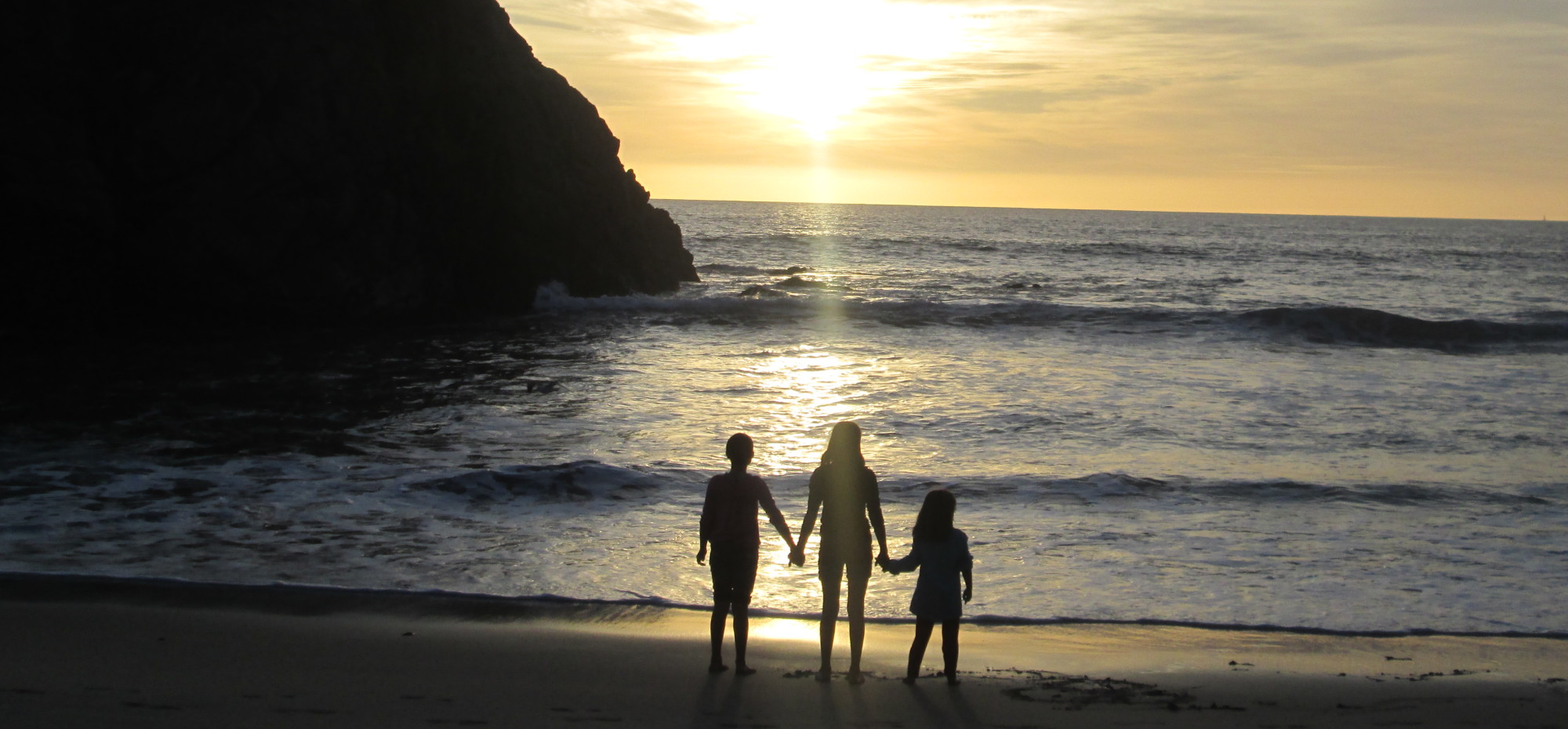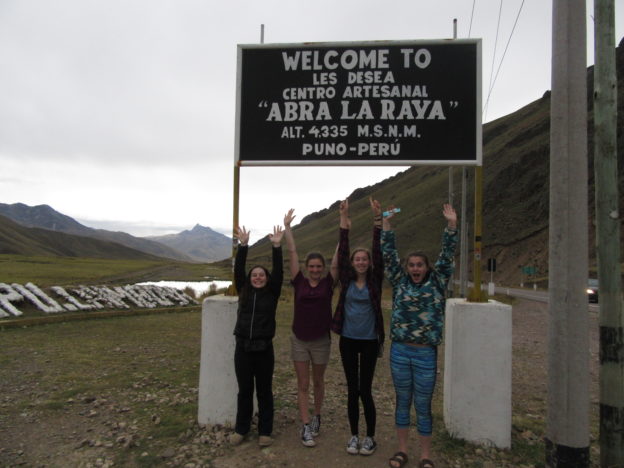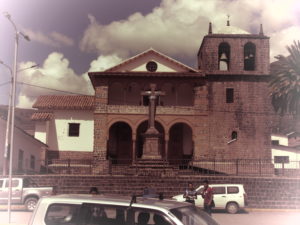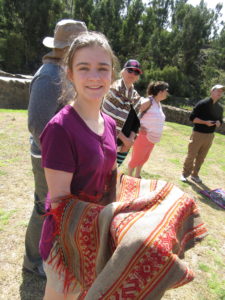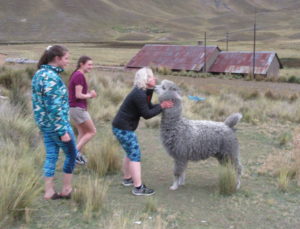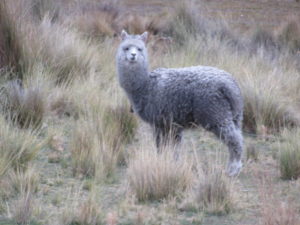Friday morning it was time to say farewell to Cusco and hop back on the bus for an eight-hour drive to Puno, on the shores of Lake Titicaca to the south. Luckily, Van had planned a few stops for us to break up the drive.
The first one was actually the only supermarket we’d seen in on our trip. We procured sandwich supplies for a lunch on the bus, since we’ve found 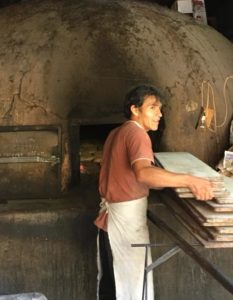 that meals for 17 people in a restaurant tend to take hours. The next stop was also food-related. In a small village square, the bus pulled over and Van told us we had 15 minutes to get some bread from someone he knew. We crossed the square, ducked down a small alley, and ended up in a courtyard in the midst of what appeared to be the homes of a group of people. It turned out the person Van knew
that meals for 17 people in a restaurant tend to take hours. The next stop was also food-related. In a small village square, the bus pulled over and Van told us we had 15 minutes to get some bread from someone he knew. We crossed the square, ducked down a small alley, and ended up in a courtyard in the midst of what appeared to be the homes of a group of people. It turned out the person Van knew 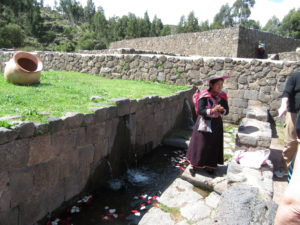 wasn’t there anymore, but there was another man working at a huge wood-fired oven (like the kind you see at Flatbread), just about to pull out some fresh bread. We bought a ton of it for pennies a loaf, and it was delicious.
wasn’t there anymore, but there was another man working at a huge wood-fired oven (like the kind you see at Flatbread), just about to pull out some fresh bread. We bought a ton of it for pennies a loaf, and it was delicious.
Our next stop, the Incan ruins at Raqchi, was a real treat. Van was acquainted with a 17-year-old girl whose mother is the local village shaman, and who is heir to the title herself. He arranged for her to give us a special tour. Rather than talk about names and dates, she told us about the religious significance of the place, and walked us through the rituals that the Inca pilgrims needed to follow to purify themselves before entering the sacred temple.
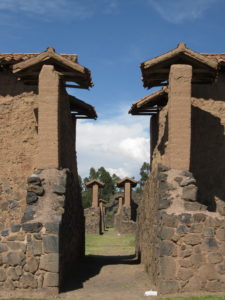
She brought out several artifacts of her own to share with us, including a 2000-year-old poncho that she passed around and even let Andrew wear!
Next to the ruins of the temple, she formed us into a circle and got what appeared to be a rock out of her blanket. She handed it to Van and told him to eat it. He expressed some skepticism, but eventually took a nibble. She explained that it was made by burning a mint plant, then forming the ashes into a rock-like substance. You were meant to nibble a piece of rock, then chew a couple of coca leaves at the same time.
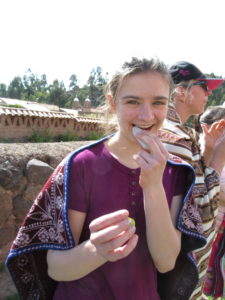
We all eventually got our chance to eat the rock, and it actually wasn’t too bad. (Kind of tasted like Necco wafers, in fact.) However, adding the coca leaves caused some kind of strange reaction that made it taste really terrible. All of us were in the circle, grimacing and clearly contemplating how rude it would be to spit out the sacred Incan food next to the sacred Incan temple. (When the second rock, made out of eucalyptus, was brought out, I elected to pass.)
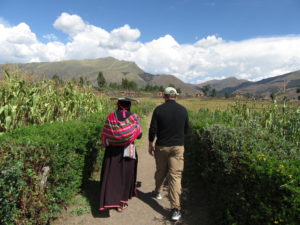
Our guide had wonderful stories, too — about playing hide and seek in the ruins as a child and seeing spirits, and about how she had become the “chosen one” (to be the next shaman). It involved almost getting struck by lightning on one occasion, and getting surrounded by a group of foxes on another. The people here have a much stronger connection with their ancestors and with ancient traditions than anyone I know in our country.
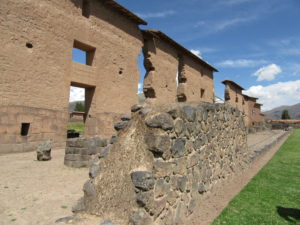 Our final stop was a desolate parking lot on the side of the road. At 14,222 feet, we were above tree line and at the highest point accessible by road in Peru, and the second highest in all of the Americas. There was a small group of artisans selling their wares, and a bathroom of sorts. For one sole (about 30 cents) we gained admission. There is no running water up here, so after each person used the bathroom the man attending it would go in with a bucket of water to flush. (Bathroom amenities are pretty scarce here in general — frequently there’s no toilet seat and/or toilet paper, and as in Central America you have to throw your toilet paper in the trash can — but this was a new one.)
Our final stop was a desolate parking lot on the side of the road. At 14,222 feet, we were above tree line and at the highest point accessible by road in Peru, and the second highest in all of the Americas. There was a small group of artisans selling their wares, and a bathroom of sorts. For one sole (about 30 cents) we gained admission. There is no running water up here, so after each person used the bathroom the man attending it would go in with a bucket of water to flush. (Bathroom amenities are pretty scarce here in general — frequently there’s no toilet seat and/or toilet paper, and as in Central America you have to throw your toilet paper in the trash can — but this was a new one.)
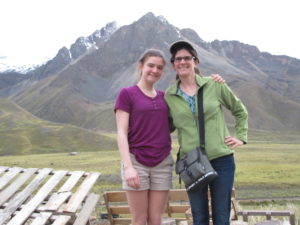 Van had a blood oxygen sensor, and we all tested out our levels. Most of us were in the low to mid eighties, with normal being 95+. It certainly explained why we felt out of breath. (The next morning, at our hotel at a bit under 13,000 feet, I was up to 91.)
Van had a blood oxygen sensor, and we all tested out our levels. Most of us were in the low to mid eighties, with normal being 95+. It certainly explained why we felt out of breath. (The next morning, at our hotel at a bit under 13,000 feet, I was up to 91.)
Some of the kids were very interested in an alpaca out back, but were told that it was a spitter. Zoe’s “friends” strongly encouraged her to approach it, but each time she got close it would look menacing and she’d retreat. However, Ann showed up, marched right over to the alpaca, and began nuzzling it. After that, the beast had been tamed and everyone was able to pet it with no spitting involved.
The excitement was not over, though. After dark, we were cruising along through the rather depressing city of Juliaca, on the main four-lane highway through the town. Suddenly we started coming across other vehicles driving towards us, coming the wrong way down the street. Now this in and of itself is not as surprising as you might think, since traffic rules here seem to be either non-existent or ignored. What WAS surprising was when we got a bit further up and found that the road ended in a large pile of rubble, with no warning.
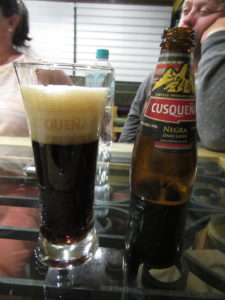
Well-deserved Cusco beer when we eventually made it to a restaurant in the much nicer Puno, on the shores of Lake Titicaca.
What followed was an epic journey that few tourists have probably ever made. We had to back up, then turn around on the highway. After that we started driving down what appeared to be a field of dirt next to a set of railroad tracks, tremendously rutted and potholed. Many other people were doing the same, so we were surrounded by cars, trucks, bikes, and the occasional livestock, all traveling along in various directions with no particular order. Once we got back to what passed as a road, the situation wasn’t much better. The streets were lined with grim-looking buildings and piles of trash. We all agreed that it seemed like some kind of post-apolcalyptic hellscape, or possibly the set of the Walking Dead. (Our driver said the city is controlled by the mafia, and there’s so much corruption that everything is falling apart.) We all breathed a sigh of relief when we eventually got back to a real road again. Unfortunately, we have to return to the Juliaca airport for our flight back to Lima. We’re just hoping they manage to maintain the runway.
